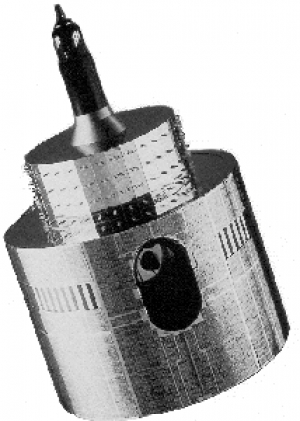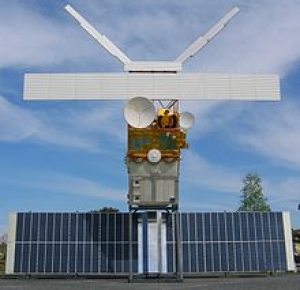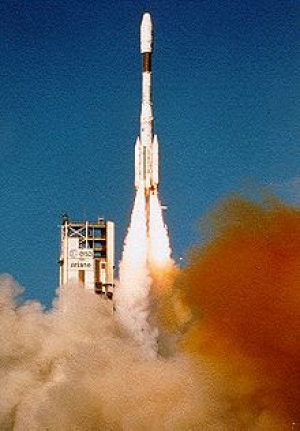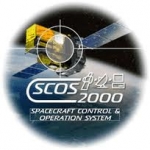Displaying items by tag: Europe
Meteosat
The Meteosat series of satellites are geostationary meteorological satellites operated by the Euopean organisation EUMETSAT.
ERS - European Remote Sensing satellite
The European remote sensing satellite (ERS) was the European Space Agency's first Earth-observing satellite, injected into a Sun-synchronous polar orbit at a height of 782–785 km.
ERS-1 and ERS–2 were launched into the same orbit in 1991 and 1995 respectively. Their payloads included a synthetic aperture imaging radar, radar altimeter and instruments to measure ocean surface temperature and wind fields.
ERS-2 added an additional sensor for atmospheric ozone monitoring. The two satellites acquired a combined data set extending over two decades.
Ariane
Ariane is a series of a European civilian expendable launch vehicles for space launch use. The name comes from the French spelling of the mythological character Ariane.
SCOS-2000
The Satellite Control and Operation System 2000 (SCOS-2000) is the generic satellite Mission Control System (MCS) software infrastructure developed and maintained by the European Space Agency (ESA/ESOC) in collaboration with European industry
ESA - ESOC (European Space Agency)
ESOC is the European Space Operations Centre, one of the centres of the European Space Agency (ESA).
Since its creation in 1967, the European Space Operations Centre (ESOC) in Darmstadt, Germany, has planned missions, operated more than 60 satellites and ensured that spacecraft meet their mission objectives. The mandate of ESOC is to conduct mission operations for ESA satellites and to establish, operate and maintain the necessary ground segment infrastructure.
ESA - ESTEC (European Space Agency)
The European Space Research and Technology Centre (ESTEC) is the European Space Agency's main technology development and test centre for spacecraft and space technology. It is situated in Noordwijk, South Holland, in the Netherlands.
At ESTEC, about 2500 engineers, technicians and scientists work hands-on with mission design, spacecraft and space technology.
ESTEC provides extensive testing facilities to verify the proper operation of spacecraft, such as the Large Space Simulator (LSS), acoustic and electromagnetic testing bays, multi-axis vibration tables and the ESA Propulsion Laboratory (EPL). Prior to the launch of almost all equipment that ESA launches is tested in some degree at ESTEC.
ESA - Headquarters (European Space Agency)
The European Space Agency (ESA), established in 1975, is an intergovernmental organisation dedicated to the exploration of space, currently with 19 member states.
Headquartered in Paris, ESA has a staff of more than 2,000 (2012).
ESA's space flight program includes human spaceflight, mainly through the participation in the International Space Station program, the launch and operations of unmanned exploration missions to other planets and the Moon, Earth observation, science, telecommunication as well as maintaining a major spaceport, the Guiana Space Centre at Kourou, French Guiana, and designing launch vehicles. The main European launch vehicle Ariane 5 is operated through Arianespace with ESA sharing in the costs of launching and further developing this launch vehicle.
ESA is managing several centres distrbuted in Europe:
- ESTEC: the ESA science missions are based at ESTEC in Noordwijk, Netherlands,
- ESRIN: the Earth Observation missions at ESRIN in Frascati, Italy,
- ESOC: the ESA Mission Control (ESOC) is in Darmstadt, Germany,
- EAC: the European Astronaut Centre (EAC) that trains astronauts for future missions is situated in Cologne, Germany,
- ESAC: and the European Space Astronomy Centre (ESAC) is located in Villanueva de la Cañada, Spain.
EUMETSAT
The European Organisation for the Exploitation of Meteorological Satellites (EUMETSAT) is an intergovernmental organisation created through an international convention agreed by a current total of 30 European Member States.
EUMETSAT's primary objective is to establish, maintain and exploit European systems of operational meteorological satellites. EUMETSAT is responsible for the launch and operation of the satellites and for delivering satellite data to end-users as well as contributing to the operational monitoring of climate and the detection of global climate changes.
The activities of EUMETSAT contribute to a global meteorological satellite observing system coordinated with other space-faring nations.
Satellite observations are an essential input to numerical weather prediction systems and also assist the human forecaster in the diagnosis of potentially hazardous weather developments. Of growing importance is the capacity of weather satellites to gather long-term measurements from space in support of climate change studies.
EUMETSAT is not part of the European Union, but became a signatory to the International Charter on Space and Major Disasters in 2012, thus providing for the global charitable use of its space assets.[1]
- public organisation
- Europe
- mission operations
- satellite operator
- meteorology
- Copernicus (EO program)
- Meteosat Third Generation
- Meteosat
- Meteosat Second Generation
- MTG
- MSG
- MTP
- Meteosat Transition Phase
- METOP
- METOP SG
- Sentinel 1
- Sentinel 2 satellite
- Sentinel 2
- Sentinel 3
- Sentinel 4
- sentinel 5P
- sentinel 5
- Sentinel 6
- JasonCS
- Jason 2
- Jason 3
- EPS
- EPS_SG
- NOAA








